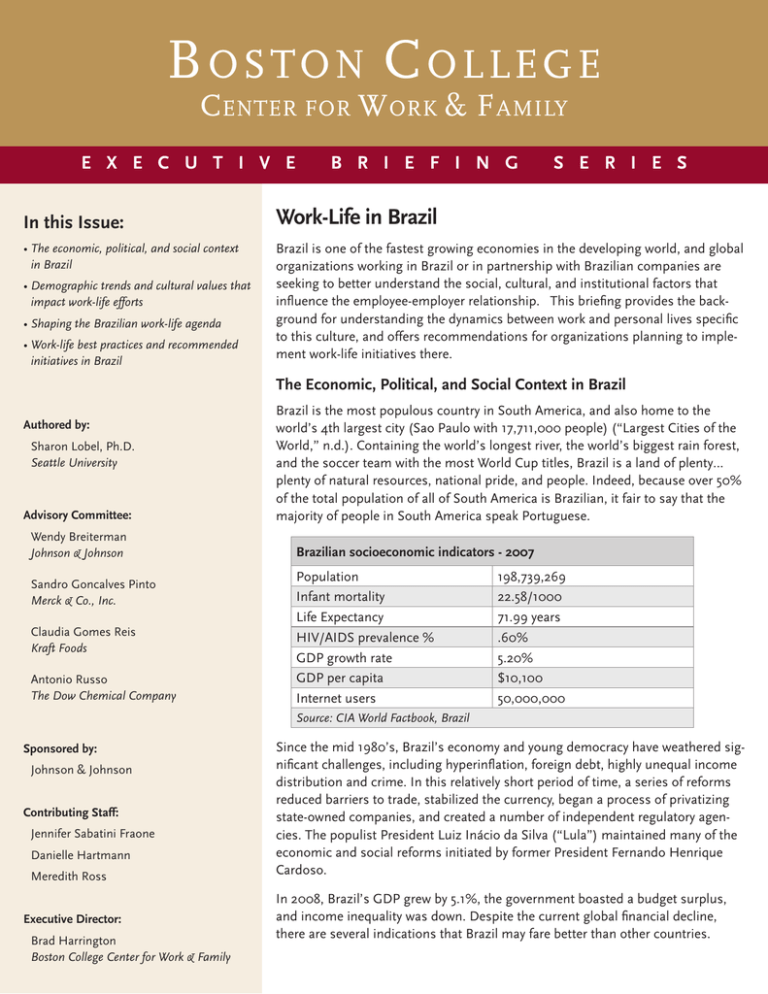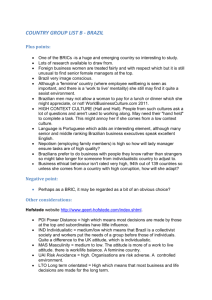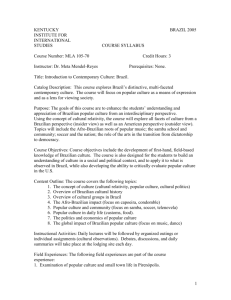B C OSTON OLLEGE
advertisement

B OS TO N C O LLE G E C ENTER FOR W ORK & F AMILY E X E C U T I V E In this Issue: • The economic, political, and social context in Brazil • Demographic trends and cultural values that impact work-life efforts • Shaping the Brazilian work-life agenda • Work-life best practices and recommended initiatives in Brazil B R I E F I N G S E R I E S Work-Life in Brazil Brazil is one of the fastest growing economies in the developing world, and global organizations working in Brazil or in partnership with Brazilian companies are seeking to better understand the social, cultural, and institutional factors that influence the employee-employer relationship. This briefing provides the background for understanding the dynamics between work and personal lives specific to this culture, and offers recommendations for organizations planning to implement work-life initiatives there. The Economic, Political, and Social Context in Brazil Authored by: Sharon Lobel, Ph.D. Seattle University Advisory Committee: Wendy Breiterman Johnson & Johnson Sandro Goncalves Pinto Merck & Co., Inc. Claudia Gomes Reis Kraft Foods Antonio Russo The Dow Chemical Company Brazil is the most populous country in South America, and also home to the world’s 4th largest city (Sao Paulo with 17,711,000 people) (“Largest Cities of the World,” n.d.). Containing the world’s longest river, the world’s biggest rain forest, and the soccer team with the most World Cup titles, Brazil is a land of plenty… plenty of natural resources, national pride, and people. Indeed, because over 50% of the total population of all of South America is Brazilian, it fair to say that the majority of people in South America speak Portuguese. Brazilian socioeconomic indicators - 2007 Population Infant mortality Life Expectancy HIV/AIDS prevalence % GDP growth rate GDP per capita Internet users 198,739,269 22.58/1000 71.99 years .60% 5.20% $10,100 50,000,000 Source: CIA World Factbook, Brazil Sponsored by: Johnson & Johnson Contributing Staff: Jennifer Sabatini Fraone Danielle Hartmann Meredith Ross Executive Director: Brad Harrington Boston College Center for Work & Family Since the mid 1980’s, Brazil’s economy and young democracy have weathered significant challenges, including hyperinflation, foreign debt, highly unequal income distribution and crime. In this relatively short period of time, a series of reforms reduced barriers to trade, stabilized the currency, began a process of privatizing state-owned companies, and created a number of independent regulatory agencies. The populist President Luiz Inácio da Silva (“Lula”) maintained many of the economic and social reforms initiated by former President Fernando Henrique Cardoso. In 2008, Brazil’s GDP grew by 5.1%, the government boasted a budget surplus, and income inequality was down. Despite the current global financial decline, there are several indications that Brazil may fare better than other countries. Among the “Ten reasons for optimism,” the newsweekly Veja highlights these: • Greater regulation of the banking system by the Central Bank and less exposure to the kinds of investments that toppled Wall Street financial institutions • High interest rates and taxes on financial institutions prevented the occurrence of a real estate bubble • An increase in the number of people emerging from poverty who are ready to join the ranks of middle class consumers and have not been participants in the formal economy that created the crisis • Large investments in green energy and discovery of oil reserves • Strong demand for Brazilian agricultural exports, including coffee, soybeans, wheat, rice, corn, sugarcane, cocoa, citrus and beef (Guandalini, Sverberi, & Borsato, 2009) A survey by Grant Thornton of 150 Brazilian firms confirms this optimism. About a third of Brazilian firms say they plan to hire more workers this year; only 16% are planning layoffs (“Situação do emprego, ” 2009). For Brazilians, the same rate of unemployment that is headline worthy in the U.S. (“Jobless rate tops 8%, highest in 26 years”) (Evans, 2009) currently represents one of the lowest rates registered in the 6 largest metropolitan regions over the past 7 years (“Pesquisa mensal de emprego,” 2009). Nonetheless, fluctuations in economic indicators deserve a watchful eye. Demographic highlights Gilberto Freire, a Brazilian sociologist, is credited with developing the popularly used term “racial democracy” to describe Brazil’s socioeconomic climate with respect to racial differences (“Racial Democracy,” n.d.). According to Freire, the relatively peaceful end to slavery and a Portuguese, as opposed to Spanish, heritage of colonialism contributed to produce a culture with little to no racial discrimination. Today, many Brazilians informally subscribe to the more “politically correct” idea that discrimination in employment is class-based rather than race-based. Nevertheless, race and economic status have a strong association in Brazil. The Brazilian census asks respondents to categorize themselves by color or race as White, Black, Mixed (Parda), Yellow (Amarela) or Indigenous (“IBGE divulga estudo especial,” 2006). The economically active population of the 6 largest metropolitan regions in 2006 was reported as: White (56.5%), Mixed (33.2%), Black (9.6%), Yellow (0.7%) and Indigenous (0.1%). The data revealed a high degree of inequality in the distribution of income, type of job, and educational level. The data on the return on gains in education showed that Whites with 11+ years of education earned 250% more than Whites with 8-10 years of education. Black and Mixed people with 11+ years of education, however, earned only 62% more than those with 8-10 years of education. Black + Mixed Average Monthly US $306 Income (“Current and Historical Rate Tables,” 2006) Average Years of 7.1 Education Children 10-17 6.7% not attending school Some college 8.2% Unemployed 11.8% Largest number Household help, of employed Construction found in: Membership: Mercosur (regional free trade association) and G-20 (economic forum for world’s 20 largest economies) GDP composition: agriculture: 5.5%, industry: 28.5%, services: 66% (2008 est.) Major export products include aircraft, coffee, automobiles, soybean, iron ore, orange juice, steel, ethanol, textiles, footwear, corned beef and electrical equipment. Brazil’s Total Exports go to: US 16.1%, Argentina 9.2%, China 6.8%, Netherlands 5.6%, Germany 4.6% (2007) Brazil’s Total Imports come from: US 15.7%, China 10.5%, Argentina 8.6%, Germany 7.2%, Nigeria 4.4% (2007) Source: CIA World Factbook, Brazil White $599 8.7 4.7% 25.5% 8.6% Service and manufacturing firms, real estate, public service Source: “IBGE divulga estudo especial,” 2006 In Brazil, the public universities tend to attract the best students through a competitive qualifying exam. Wealthy students, who can afford high-quality private schools and -2- costly exam preparation services, are more likely to obtain admission to these free universities. In an effort to address these disparities, the Brazilian Senate approved a proposal easing access for disadvantaged groups to public universities. With the recent proposal, 50% of university slots would be designated for public school students and the proportion of spots available would be allocated according to the distribution of the Black, Mixed, and Indigenous populations in each state. Half of the spots for non-White students would be set aside for those with a family income of up to 1.5 minimum salaries per person (equivalent to US $300 in March 2009). The proposal has not yet been passed by the Congress and it is coming up against opposition from those who believe that quotas should be assigned based on socioeconomic status alone or based on merit alone. Opponents of the quota system argue that the government would do better to invest in public elementary and high school education in order to prepare students to be competitive with graduates of private schools (“Senado discute cotas nas universidades,” 2009). more and devote less time to the household; 38% indicated they would prefer to stop working or work less, while increasing time devoted to the household (Abamo, 2001). The number of women in the first group is greater than the number of women actually working, highlighting the potential for facilitating their entry into the workforce with family supportive programs. Part-time work of up to 25 hours per week, for example, is not yet readily available in the formal sector, representing only 5.7% of total jobs and only 2% of industry jobs (“Relação annual de informações sociais,” 2001). In the 2001 survey, although 87% of women agreed that men and women should share housework equally, 85% also agreed that when there are young children, women should stay home to care for them. Since, on average, women earn only 71% of men’s wages, (“Pesquisa mensal de emprego,” 2009) it may make economic sense for women to stay home or be principal care givers when children are born. At the same time, when women with a college education earn 40% less than men with the same Culture and Values Brazil might be described as having a “work hard, play hard” culture. About half of both men and women in the workforce work between 40 and 44 hours per week. Despite the legal maximum work week of 44 hours, almost 40% of men and a quarter of women work more than 45 hours weekly. Brazilians value work, but they also value family and leisure time. During the annual Carnaval period and the World Cup (every 4 years), work can effectively come to a halt. Spontaneous national holidays may be declared as the Brazil team advances in the final events of the World Cup. On the weekends, many people visit with family members in large, impromptu gatherings. Socializing with work colleagues is often limited to the workday and may include eating a sit-down lunch at a local restaurant. Brazil has seen the same trends as in many other countries, including a decline in number of traditional nuclear families, an increase in single parent families with female heads of household, greater rates of divorce, a decline in fertility rates, increasing numbers of women with higher levels of education, and aging of the population. Women have been entering the workforce in ever greater numbers. Between 2003 and 2008, the number of female workers in the 6 largest metropolitan regions grew by 20.6% to 44.7% of women (relative to 57% of men)(“Pesquisa mensal de emprego,” 2009). Despite these trends, the time women dedicate to family and household tasks has not declined. In a nationwide survey, conducted in 2001, 55% of women said they want to work “A lot is expected of Brazilian women…There are cultural issues that affect flexibility options, making it extremely difficult for women to balance family life and self and other responsibilities that are not related to the workplace.” – Arisa Batista Cunningham, Vice President of Global Diversity, Johnson & Johnson level of education (“Tempo, trabalho e afazeres domésticos,” 2007), it is apparent that there is more to the equation than economics. As in other countries, proactive monitoring of employment practices, which is more prevalent in large companies, is an important factor in reducing salary inequities between men and women. In traditional families with young children (married couples with children under the age of 14), women spend an average 29.7 hours weekly in household activities (“Tempo, trabalho e afazeres domésticos,” 2007). Having a male partner does not reduce the amount of time spent on household tasks; in fact, it increases it! In 2005, 51.1% of men reported involvement in household tasks. This is consistent with the 2001 survey in which a majority of the women interviewed (57%) said their male partner had done no housework at all in the week prior to being interviewed. Among men, those over the age of 60 devote more time to household tasks than any other group of men. -3- Single adult children often live with their parents until much later in life than in other countries. After adult children marry and establish their own households, it is not uncommon for aging parents to move in with them. Families, and primarily daughters and daughters-in-law, serve as the principal source of assistance to elders (Saad, 1999). In return, elders may contribute to childcare and share their retirement income, which could explain why female heads of household, with at least one elder in the home, have a higher rate of participation in the workforce and higher income than those in homes without an elder relative (Sorj, 2003). Cultural patterns of multiple generations in the household or in close proximity ease the challenges of managing work and family responsibilities. The Civil Code, adopted in January 2003, changed the definition of family, as well as endorsing a more equal division of power between spouses. Prior to 2003, “pátrio poder” institutionalized the patriarchal family by assigning authority over children and legal responsibility to men as the heads of household. Under the new legislation, “familia poder” or family power is to be shared between husband and wife. Other contributions of the new code allow the establishment or proof of paternity, even against the father’s wishes, paving the way for reluctant fathers to pay alimony. In cases of divorce prior to 2003, child custody was preferentially assigned to mothers. Now the parent with the better moral, educational and financial profile is assigned custody. Finally, the new definition of family legally applies to “stable unions” between heterosexual adults, as well as single parent families. ment Goals. These two agendas intersect with the growing interest in corporate social responsibility. In the private sector, human resource professionals face the same challenges as elsewhere to link their programs and policies with business strategy. By taking care of employees (and the employee’s family in some cases) with Quality of Life initiatives, companies attract, retain, and develop human capital. At the national level, the work-life agenda, although not referred to as such, involves reducing poverty levels and increasing access to education and healthcare, so that impoverished Brazilians can improve their standard of living and potential for employment in the formal labor market. Despite the economic progress Brazil has experienced, as of 2006, 15.6 million city dwellers were still living in housing without a potable water supply. More than a quarter of rural dwellers lack even the most primitive type of sewage system and 34.6 million urban dwellers lack sanitation. Up to 8% of children under the age of 2 in the Northeast suffer from malnutrition and 7.5 million Brazilians earn less than US$1 per day. The United Nations Millennium Development Goals, adapted to the Brazilian reality, describe a variety of aggressive targets to address these and other problems by 2015 (“Objetivos de desenvolvimento do milênio,” 2007): • Reduce by 1/4 the number of people with a per capita income of less than US$1 per day and eliminate chronic hunger • Guarantee that all Brazilian children complete basic education (7-14 years), irrespective of race, color, or sex The equality of men and women in both public and private life was first recognized in the Constitution of 1988, then reinforced by the Civil Code and by many of the demographic trends indicated above, principally the increase of women in the workplace. Nonetheless, despite these patterns and the presence of paid household help in middle and upper class homes, the typical division of labor in the Brazilian household and the importance ascribed to family in Brazilian culture make the traditional view of gender roles fairly resistant to change. • Eliminate gender inequality in primary and intermediate (15-17) education by 2005 and in all levels of education by 2015 • Reduce infant and child (<5) mortality by 2/3 • Halt increase in rates of death from breast and uterine cancer • Provide universal health care coverage for sexual and reproductive health • Control the spread of HIV/AIDS and the incidence of malaria and reduce current rates Shaping the Work-Life Agenda The work-life agenda in Brazil has two distinct branches, targeting two very different populations. Within the private sector, work-life is part of the Quality of Life movement, which emphasizes improvements in the health and well-being of employees, and sometimes, their families. Within the public sector, work-life is part of the human rights movement, which focuses on the types of issues addressed by the United Nations Millennium Develop- • Halt destruction of natural resources, implement sustainable development policies, reduce by 1/2 the number of people without access to potable water and sanitation, improve living conditions for 100,000,000 people A manuscript by the Ethos Institute on private sector responsibilities in relation to the Millennium Goals (“O compromisso das empresas,” 2006) details actions some companies have already taken. For example: -4- • Banco do Brasil (banking), Odebrecht (construction), Mineradora Rio do Norte (mining), and Seara (meat and chicken processing) have given financial and technical support to small farmers in rural areas • Petrobrás (oil) has developed a literacy project involving 15,000 students in 5 states • Aché (pharmaceutical) has screened 5000 students in public schools for anemia •B elgo-Mineira (steel) and Pfizer (pharmaceutical) offer information on preventing sexually-transmitted diseases and drug abuse in São Paulo and 20 municipalities in the Northeast With a focus on nutrition and wellness, Kraft Foods has provided direct assistance for 7,000 children from birth to six years old at 40 early childhood centers in São Paulo. Partnering with CREN – Center of Recovery and Nutritional Education, Kraft sponsors activities that include training professional staff and families to monitor malnutrition and obesity and to improve physical fitness. Building on its success with these initiatives, Kraft expanded the program to also target children and youngsters between six and twelve years old and to develop a similar focus in another metropolitan center (Maceió) in the northeast of Brazil. Public and Private Employment and Human Resource Policies Unlike a number of South American countries (Argentina, Bolivia, Chile, Peru, Uruguay, Venezuela, and most recently, Paraguay in 2007), Brazil has not ratified the Work With Family Responsibilities Convention adopted by the International Labor Organization (ILO). This convention establishes that national policies should support people with family responsibilities who also work by reducing conflict between work and family roles. However, in March 2009 in the Brazilian capital, a conference on work and family linkages demonstrated that attention is being given to this topic as a national priority (“Trabalho e Família,” 2009). The conference was a joint effort of the ILO, the Ministry of Labor, the Brazilian Special Secretary for Policy on Women, and the United Nations Development Fund for Women. The conference was a forum for discussion of gender roles and definitions of “family” with Brazilian private and public sector representatives. The majority of legislation that pertains to work and family protects workers who are part of the formal sector with a carteira assinada, an official record of employment and “on-the-books” compensation that is signed by the employer. The formal sector includes all types of employ- ment in either the public or private sectors which offer regular wages and hours, which carry with them employment rights, and on which income tax is paid. Workers in this category, including government employees and military, comprise a little more than half of the total workforce. Only 40% of working women have a carteira assinada, as compared to 50% of men (“Pesquisa Mensal de Emprego,” 2009). Parental leave: Congress enacted a law, which will go into effect in 2010, which gives private sector employees the option to extend paid maternity leave from the current 120 to 180 days (funded by Social Security). As an incentive, employers will be able to reduce their tax obligations by the amount equivalent to the two additional months of salary for the employee (“Aprovado projeto que amplia licençamaternidade,” 2008). In conjunction with maternity leave, pregnant employees are guaranteed job security from the time of confirmation of pregnancy until five months after birth. If an employee is dismissed after this period, she is entitled to severance pay equivalent to one month’s salary for every year of service. When work conditions interfere with pregnancy, she is entitled to a job transfer with return to original job after delivery. Mothers who adopt children under the age of 1 are also entitled to 120 days of leave. Those who adopt children 1-4 years old receive 60 days and 30 days for 4-8 years old, with leave pay varied according to age of child. Fathers of biological or adopted children are entitled to 5 days of leave paid by the employer. Mothers are entitled to 2 periods of 30 minutes each for breastfeeding during an infant’s first 6 months. This period may be extended if necessary due to the child’s health. Childcare: Employers with more than 30 female employees must designate a location for childcare when mothers are still breastfeeding. The location may be at the place of employment, at a location contracted by the employer, or paid for by a subsidy at a location of the mother’s choice. Large employers are most likely to comply with this law or to offer more generous support. For example, Merck Sharp & Dohme provides a monthly allowance, equivalent to 50% of the minimum wage established in their collective bargaining agreements, to female employees with children up to the age of 30 months in childcare. For children under the age of 3, access to public crèches,or daycare centers, is a right to be addressed by municipalities, as is access to public preschools for children ages 4-5. Due to lack of public resources to meet the demand, only 13% of eligible mothers are able to obtain slots for their children in the public crèches; and the federal government has been unable to keep up with its promise to expand capacity (Cieglinski, 2008). Moreover, critics question whether the crèches should continue to -5- be exempt from the requirement to provide “education” as well as childcare. Work Hours: The maximum working week is 44 hours, not exceeding 8 hours per day. There is a 50% premium for overtime, although some collective bargaining agreements require overtime pay up to 100% on normal work days and up to 200% for weekends or holidays. Trade unions have resisted platforms supporting flexible work arrangements, in favor of reducing work hours (Sorj, 2003). When approved by 50% of employees, an employer may implement an hours bank. This practice is similar to “comp time.” Kraft, for example, has an hours bank for office staff. At the discretion of the employer, work hours may be increased without payment of overtime, or decreased without reduction in pay, by using compensatory time earned at some other point during the year. Financial assistance: Workers in low income families (earning less than US $323 per month) with children under the age of 14 or with a disability, receive a small benefit of US$11 per child per month (XE Current and Historical Rate Tables, 2009) (and per parent when both parents work). Payment is contingent on the child attending school and receiving required vaccinations. Adults with a disability and seniors over the age of 67 may receive the minimum monthly salary, provided they are unable to work and have no other source of income, and their family has a per capita income equivalent to less than 1/4 of the minimum wage. Because the assistance depends on family income, it is designed for families unable to support the beneficiary, not for the beneficiary himself or herself. Families with less than 1/2 of the minimum wage receive “scholarships” for children 6-15 years, provided they attend school. This measure is intended to discourage families from putting young children to work to contribute to family income. Child labor: Brazil has ratified several ILO resolutions including a definition of child labor as referring to work by any child aged 13 or under, adolescents aged 14-15 working in a job that does not contribute to their education or vocational development, and teenagers 16-17 who work in poor conditions, such as night shifts (“Brazil”, 2009). Still, 1.4 million Brazilian children between the ages of 5-13 work, primarily in agriculture, without pay (“Suplemento Trabalho Infantil,” 2008). Retirement: In 2006, the average age of retirees was 57 for men and 52 for women (“A idade mínima para se aposentar,” 2006). These relatively young ages stem from the two types of retirement: retirement by age and retirement by years of service. Urban employees are eligible for retirement when they reach the age of 65 for men and 60 for women. Rural workers and public sector employees are eligible for retirement when they reach the age of 60 for men and 55 for women. With some exceptions, workers need to prove that they have made 15 years of contributions to Social Security. Rural workers, domestic workers, and self-employed individuals receive the equivalent of the minimum monthly salary. For retirement by years of service, men need 35 years of contributions to the Social Security System and women need 30. In 2003, public sector employees became eligible to retire earlier with a reduction in benefits: men may retire at the age of 53 with 30 years of contributions and women at Chart 1: Prevalence of Benefits 100% Health Benefit 98% Meal Allowance 94% Life Insurance Dental Plan 81% 76% Employee Loans 71% Private Pension Funds Short-Term Disability 69% Medical Checkup 65% 59% Prescription Drug Benefits 3% Flexible Benefits 0 20 40 60 80 100 Source: Towers Perrin, Benefit plans in Brazil, 2007. Note: “Flexible benefits” refers to a “cafeteria plan” which allows employees to choose type and level of benefits in a package. -6- the age of 48 with 25 years of contributions. For non-public service employees, the retirement benefit is calculated in terms of age, years of service with Social Security contributions, and life expectancy. Employer-Sponsored Programs and Practices Under the Quality of Life umbrella, companies offer a variety of voluntary programs related to health and wellbeing. In 2007, a Towers Perrin survey of 14 public sector employers, 106 private sector, and 180 private multinational firms (total = 300) reported the 10 most prevalent benefits as shown in Chart 1. The category “Health Benefits,” offered by all the respondents in the Towers Perrin survey, includes perquisites such as Merck Sharp & Dohme’s Occupational Health Gym, which offers consultations on correct posture for the prevention of occupational related injuries, and Dow Brasil’s gym at every site. In its 2008 annual survey, Exame, a newsweekly similar to Fortune, singled out Eurofarma as the organization with the best Health and Quality of Life programs. The pharmaceutical company turns off access to email when an employee goes on vacation, has employees donate a kilo of food to cover their monthly membership in the fitness center, and provides a 70% subsidy for employees who use Eurofarma’s personal trainers, nutritionists, and beauty salon. Employees receive free health care, free medication from Eurofarma and subsidized medication from other pharmaceutical companies. Health care benefits extend to same sex domestic partners. Pregnant employees learn about prenatal care at organized information sessions and receive home visits by a nurse and dietician for 3 months following delivery. In the same survey on Best Companies, Volvo was distinguished as the Best Place to Work for its self-managed teams, annual climate surveys, Pizza Fridays, Personal Development Plans, 50% tuition subsidy for career development education, coaching, health clinic and other health benefits, as well as its support for an organization that houses 40 children waiting for adoption. Dow Brasil has been mentioned for 12 consecutive years on Exame’s annual list of 150 Best Places to Work. To ameliorate stress, some companies offer programs for stress management and advice about identifying passion and purpose in work. Dow’s Employee Assistance Program provides a no-cost service to employees and family members who can make confidential phone calls for legal or financial advice, or to discuss psychological issues, substance abuse, and other private matters. In August, 2007, the Johnson & Johnson Family of Companies - Brazil introduced a tobacco-free policy and received the “Tobacco Free Environment Seal” from the State Health Department. The company offers employees and their family members the opportunity to participate in smoking cessation programs. Other initiatives include events for adolescent children of employees focusing on behavioral risk prevention such as HIV/AIDS awareness, health literacy, and supporting healthy choices. Last year, the company sponsored a special event in honor of Mothers’ Day with a variety of health promotion activities specially planned for moms. Brazil has the distinction of utilizing on-site Employee Assistance Program (EAP) professionals for more than thirty years. At the Johnson & Johnson location in San Jose dos Campos, a corporate culture of health that promotes physical, emotional, and professional strength is sustained through the collaboration of the EAP staff and Human Resources who demonstrate passion for improving not only the lives of the Johnson & Johnson workforce, but also the health of the local community. In 1991, federal legislation established quotas for companies with respect to people with disabilities. Companies with fewer than 100 employees need to hire 2% of employees with disabilities; those with 101 to 500 employees have a 3% quota; 500 to 1000 employees are at 4% and above 1000 employees, the requirement is 5%. Because of greater enforcement of this regulation in the past 4 years, more companies have been audited and fined for non-compliance. In order to increase the pipeline for eligibility, Dow is partnering with the consulting firm Serasa to create a supportive and inclusive environment for individuals with disabilities. Dow’s sponsorship of DEN, an employee network for those with disabilities, directly helps new employees, their colleagues and managers with the assimilation process. Flexible work arrangements are an important tool for attracting and retaining employees. In its worldwide survey, Merck Sharp & Dohme found that flexible work arrangements were a decisive factor in choosing to work at the pharmaceutical company. Eighty-five percent of employees said flexibility influenced their desire to remain with the company and 68% said that without this option, they would be more likely to leave (Oliveira, 2009). Employees in Brazil have the option of a full range of flexible work arrangements, subject to an analysis of impact on business results and coworkers, approval by the manager, periodic review, and conformity with local labor laws and union agreements. The company also has a “Holiday Bridge” policy, which permits employees to work an additional -7- 50-60 minutes during the week and to take “comp time” in the form of a day off close to a holiday (e.g., take Monday when Tuesday is a holiday) or to end work at 3:00 on Fridays. A Publication of the Boston College Center for Work & Family In addition to the benefits highlighted in the Towers Perrin survey above, Kraft also offers the following: About this Series • Partial payment of preschool fees for working mothers with children under 2, childcare discounts, phased return to work for a 2 month period beyond the legal maternity leave, private areas for breastfeeding mothers to pump and store breast milk • Flexible work arrangements for non-production employees, including flexible start and stop times and Friday Flex in the summer • Diversity training on women’s issues and a Women’s Council • Service awards, such as electronics and home accessories, for employees at 5-year intervals, after the first 10 years of employment • Active recruiting of people with disabilities (257 employees in Brazil, 2009) Summary and conclusion: Brazilian labor law and practices in private companies leave a lot of room for progressive employers to address gaps with programs and policies that span a child’s development and support fathers, as well as mothers. The aging population and a longer life span mean that private pensions (now offered by 71% of the firms surveyed by Towers Perrin) will become even more important to supplement or replace a strained Social Security system. Some benefits that are now more common in larger companies would be of value if made available to employees in smaller companies. Three broad recommendations emerge: • Companies should consider flexible work arrangements, expansion of childcare and eldercare options, and other initiatives to respond to demographic trends such as the increasing numbers of single parent families and the aging of the population. • Organizations should recognize and reward leaders who not only understand and aim to reduce the persisting inequalities between men and women, but also encourage changes in traditional attitudes and practices that maintain these inequities. • Social responsibility and the human rights agenda are opportunities for business partnerships with communities and the public sector to address underserved, impoverished Brazilians. -8- Written for an executive level audience, the Boston College Center for Work & Family Executive Briefing Series addresses topical and strategic issues of particular relevance to the current business climate. The series highlights research findings, data trends and best practices in a concise format, aiming to foster action-oriented dialogue within organizations. Each issue features an accompanying PowerPoint presentation that captures key points and includes a section for practitioners to customize and add organization-specific data. About the Center Since its founding in 1990, The Boston College Center for Work & Family has been a national leader in helping organizations create effective workplaces that support and develop healthy and productive employees. The Center provides a bridge linking the academic community to the applied world of the work/life practitioner and has three main focus areas: research, membership, and education. The Center is committed to enhancing the quality of life of today's workforce by providing leadership for the integration of work and life, an essential for business and community success. The Boston College Center for Work & Family 22 Stone Avenue Chestnut Hill, MA 02467 Ph: (617) 552-2844 Fax: (617) 552-2859 http://www.bc.edu/cwf








